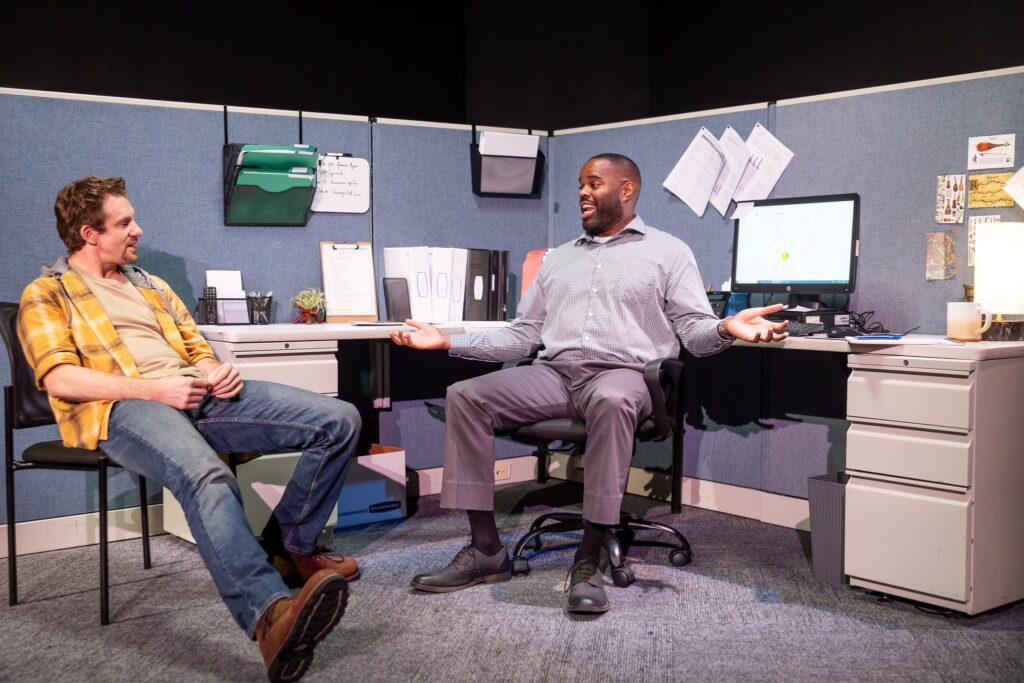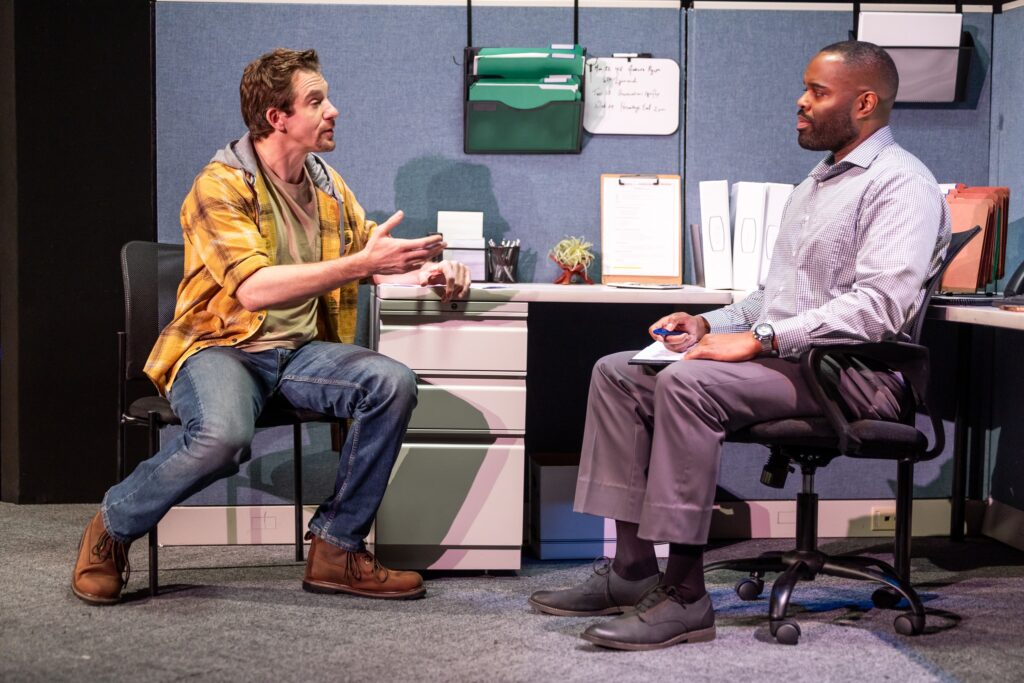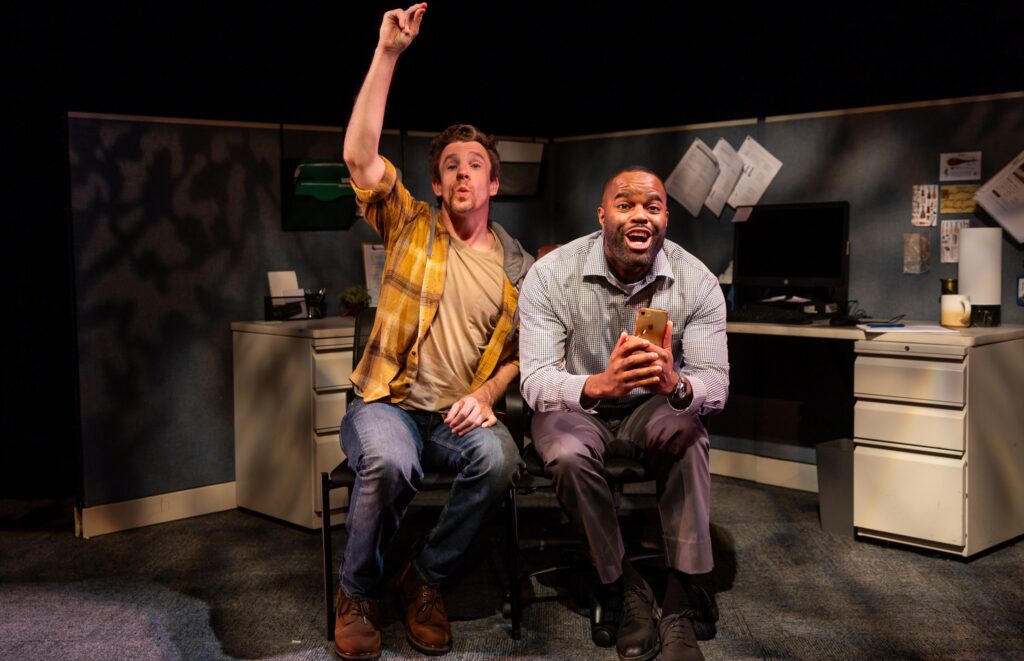
Photos: Nile Scott Studios
‘A Case for the Existence of God’ written by Samuel D. Hunter. Directed by Melinda Lopez. Scenic Design by Cristina Todesco. Costume Design by KJ Gilmer. Lighting Design by Elmer Martinez. Sound Design by Audrey Dube. Performing at the Calderwood Pavilion at the BCA, 527 Tremont Street, Boston, through February 17, 2024.
By Linda Chin
Playwright Samuel D. Hunter’s A Case for the Existence of God is set in Twin Falls, Idaho (population 51,807 and racial makeup 88.5% White, 0.7% African American), in the present or recent past. The municipal seal includes an illustration of the pair of waterfalls that gave the city its name, and with acres of natural beauty in abundance, Twin Falls and this area of south-central Idaho is often referred to as “God’s Country” – full of spirituality and soul, presumably where dreams are fulfilled, and hearts uplifted. The city’s motto, People Serving People, is borne out by institutions and businesses sizable and small, including a yogurt factory and supermarkets, banks and a mortgage company, schools, and a daycare center. But like most Americans in the present or recent past, many Twin Falls residents are suffering from a crisis of human loneliness.
Most of the action in this two-hander takes place on a simple unit set (designed by Cristina Todesco) – a small, largely unadorned, windowless, and soulless cubicle in a nondescript office suite. Two thirty-something men, Keith (De’Lon Grant), who is Black, single, and gay, and Ryan (Jesse Hinton), who is White, married but soon-to-be-divorced from his wife, and presumably straight, recently met at their daughters’ daycare center (at pick-up time, when men make up the minority), and struck up a conversation about a property on the market. It turns out Keith is a mortgage broker and Ryan a prospective homebuyer and client, and they schedule an appointment to start the process of applying for a loan.

Initially, the duo’s meetings are limited to disclosures about Ryan’s finances – his limited income as a worker in the yogurt factory and his assets for a down payment limited to a rundown pickup truck (and two guns). Ryan also revealed harrowing aspects of his childhood – his parents had significant psychiatric disabilities and were alcoholics. Over time their discussions grow to include their fears about fatherhood and the future – Ryan’s urgency to buy a house was to demonstrate to the courts (in their custody battle) that he is a competent father and provider to Krista. Keith has been fostering Willa (whose mother was a meth user) since birth, with plans to adopt her, but under the state’s family reunification act may lose her to a distant aunt who doesn’t want her niece parented by a gay man. Feeling neither competitive with nor judged by the other – but trusted and understood – the unlikely pair develops a close platonic relationship that extends outside the office.
In ensuing scenes, we see two grown men, Keith and Ryan, relaxing and watching television while sharing a bottle of whisky and cheering each other on – and commiserating – through their crises of adoption, custody, divorce, impending loss, and loneliness. Or, like Kramer v. Kramer, we see two fathers happily hanging out on the sidelines at the playground and warning their kids not to climb too high. And their joy in finally capturing – for posterity – the perfect photo of their adorable girls, Krista and Willa, holding hands.

Grant and Hinton are masters of their craft. For most of the play, the actors – atypically and remarkably – perform from chairs, delivering their dialogue, expressing their emotions, and moving their faces and bodies from a sitting position. The transitions in scene and locale are marked with lighting changes, including partial blackouts and special effects (designed by Elmer Martinez), with “chair choreography” where they slide/roll their way to different locations on stage, and with props that gain prominence – e.g., a baby monitor (sound design by Audrey Dube).
Of note, neither Keith nor Ryan stands up until the last cubicle scene, and both remain standing through the production’s final scene, which takes place off the unit set. Spellbound by De’Lon Grant and Jesse Hinton’s superb acting, audience members stay seated – many at the edge of their chairs – and lean in all the way through the ninety-minute, intermission-less production, not rising until the rousing standing ovation. For tickets and information, go to: https://speakeasystage.com/

